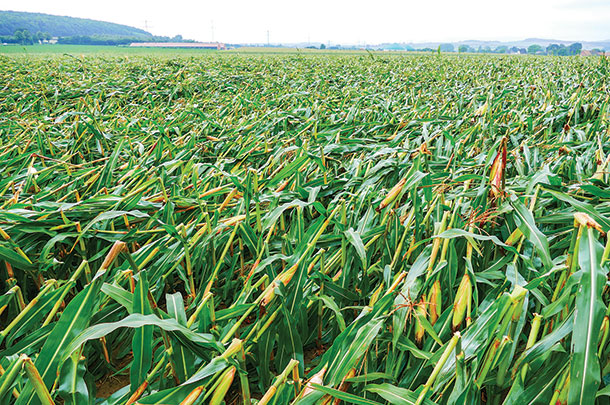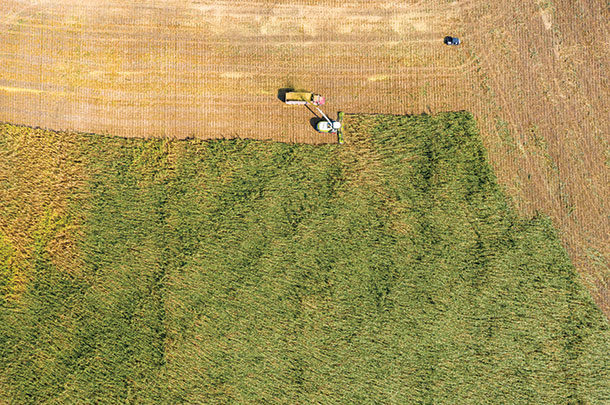While producers are faced with their fair share of obstacles throughout the harvest season, downed corn can be one of the most challenging.
Strong winds, thunderstorms, hurricanes and hailstorms, if severe enough, can all lead to lodged or knocked-down corn at harvest. In 2020, California dealt with strong winds, and millions of Midwest acres were affected by a severe derecho storm which brought damaging winds and heavy rain to cornfields.
In addition to adding time and labor to the harvest, downed corn can affect the nutritional value and fermentation of the silage. The severity of the storm will have a substantial effect on how the nutritional value of your corn holds up. Lodged corn has a chance for being contaminated with yeast and mold, as well as bacteria and fungi. Additionally, downed corn could increase the ash content in the forage. A greater ash content will lead to greater wear on harvesting equipment, lower forage intake, reduced digestibility, negative fermentation and diluted nutritional value.
Typically, farmers will try their best to salvage the downed corn and harvest what they can. While not all that easy, there are several tips that producers should keep in mind while harvesting downed corn to make the most out of each acre.
Consider your options
Walk through your fields and assess the damage before making your plan. Do you have excess debris? Is the crop salvageable? If it’s not, this is when you consider your crop insurance coverage options. While walking through the fields, producers should also take note of the direction of the downed corn. This is helpful to keep in mind when it is time to power up the forage harvester. Also, contact your forage harvester dealer – many manufacturers have bulletins, kits, tips and tricks on how to handle downed corn.
Monitor moisture levels
Corn silage is a high-moisture crop at 55% to 72% water. However, the moisture level can be difficult to manage since downed corn may dry unevenly. Also, diseased or damaged plants will dry faster than healthy plants. Producers must keep in mind that if silage is too wet, there is a risk of butyric acid forming and losing nutrients. If the silage is too dry, it will not ferment or pack well. The ideal range is 62% to 68% moisture. Sampling silage can be done in several ways, including spot-checking and pulling random stalks in a field to check the moisture.
Use optimal header height
The height of the header on the forage harvester should be determined by how far the corn is off the ground. If the corn is completely flattened, the header should be lowered as much as possible. If not, the header should be lowered to just under the corn. Some headers have a tilt adjustment: In severely downed corn, the header should be tilted down to lift the crop to the head. Be careful of any rocks or heavy debris.
 The bad news is: Weather damaged my corn and nutritional value will be lost. The good news is: There is a lot of salvageable feed if the harvest is managed well. Photo courtesy of CLAAS.
The bad news is: Weather damaged my corn and nutritional value will be lost. The good news is: There is a lot of salvageable feed if the harvest is managed well. Photo courtesy of CLAAS.
Slow it down
Harvesting downed corn should be a slow and steady process. If the speed of the forage harvester is too high, the header will become clogged. Being patient while harvesting the lodged crop is more efficient in the long run. On the other hand, one tip to maximize downed crop is to speed the header up. The faster the gather drums can spin, the more material they can gather. This can be done hydraulically or with speed-up pulleys depending on the model. Consult your operator’s manual, as some manufacturers will recommend the removal of specific points on the header to allow the stalks to get closer to the gathering device.
Harvest angles
Most rotary heads, when equipped with downed corn kits, work the best when the operator can harvest the downed crop on an angle to the direction the crop is laid. For example, if the crop is laid straight east, the operator should harvest the crop 45 degrees off of east. This way, crop can be harvested in both directions. Note: Some types of heads do not like taking the tassel first. Therefore, in the example above, try to avoid harvesting west. Some headers can only harvest east as the butt of the stalk needs to come into the header first. This situation is not ideal, as it means the operator has to “deadhead” back to the other end of the field.
Sort out the good from the bad
Not all corn silage will be acceptable feed – it’s time to weed out the bad stuff. Producers should sort out the damaged corn silage from the good-quality silage being harvested because of the lower nutritive value and possible poor fermentation.
Consider a silage inoculant
Good fermentation is key. Researchers at the University of Wisconsin – Madison recommend using a silage inoculant. More soil is being taken in by the harvester when gathering downed crop, so producers can expect greater yeast and mold contamination as well as higher ash levels. Producers should incorporate a proven inoculant containing L. buchneri because these inoculants decrease yeast and mold growth during feedout. This also improves aerobic stability and hygienic quality and prevents further dry matter losses or problems during feedout.
While downed corn can require more time and effort at harvest, it can still lead to perfectly acceptable feed for cattle. Nutritive corn silage provides many benefits to livestock, including providing energy, starch and fiber for cattle with minimal nutritional losses. Before chalking up the loss to downed corn, consider these tips to make the most out of each acre.









